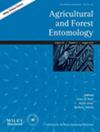利用相机诱捕了解昆虫捕食者与猎物之间的相互作用:当前研究综述与展望
IF 1.8
3区 农林科学
Q2 ENTOMOLOGY
引用次数: 0
摘要
生态学家越来越多地使用照相机来研究物种分布和相互作用。它们主要用于研究哺乳动物等大型动物,但也可用于记录包括昆虫在内的小型无脊椎动物。相机捕捉器可在指定视野内捕捉图像,可用于生物监测和调查昆虫相关的相互作用,如捕食。了解昆虫对猎物的捕食对农业和保护生物学有直接影响,可以识别捕食者物种并量化生物防治。本综述考察了 1988 年至 2024 年 3 月间发表的 28 项研究,重点关注使用照相机监测昆虫捕食者与猎物之间的相互作用,主要针对农业害虫。这些研究使用的记录设备各不相同,而且往往受到空间和时间的限制,因此研究结果难以在更大范围内推广。我们概述了设备选项、相机设置、视频记录与图片记录的优劣、夜间成像策略、触发机制、设备成本以及防盗防破坏策略。此外,我们还讨论了提高图像处理效率的途径,包括通过人工智能方法提高捕食者识别能力。我们还讨论了与捕食者识别分类水平限制有关的挑战。最后,我们为有兴趣使用照相机技术的研究人员提供了指导,并就照相机技术在昆虫保护和生物防治工作中的应用提出了未来展望。本文章由计算机程序翻译,如有差异,请以英文原文为准。



Understanding insect predator–prey interactions using camera trapping: A review of current research and perspectives
Comprendre les interactions prédateurs-proies chez les insectes à l'aide de pièges caméra: un état de l'art des recherches et perspectives
求助全文
通过发布文献求助,成功后即可免费获取论文全文。
去求助
来源期刊

Agricultural and Forest Entomology
农林科学-昆虫学
CiteScore
3.60
自引率
6.20%
发文量
66
审稿时长
>24 weeks
期刊介绍:
Agricultural and Forest Entomology provides a multi-disciplinary and international forum in which researchers can present their work on all aspects of agricultural and forest entomology to other researchers, policy makers and professionals.
The Journal welcomes primary research papers, reviews and short communications on entomological research relevant to the control of insect and other arthropod pests. We invite high quality original research papers on the biology, population dynamics, impact and management of pests of the full range of forest, agricultural and horticultural crops.
 求助内容:
求助内容: 应助结果提醒方式:
应助结果提醒方式:


